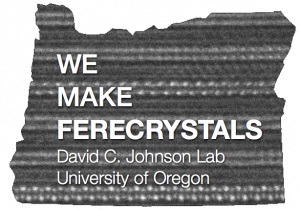Dave Johnson’s research is at the interface of chemistry and physics and at the forefront of
materials research. His group has pioneered a new approach to the synthesis of extended solids that permits them to prepare families of new nanostructured and kinetically stable compounds. The synthesis approach depends on controlling composition and diffusion lengths within a precursor that is designed to self-assemble into the desired new compound, as shown on the right. His group determines the crystal structures and measures the electrical and magnetic properties of these new compounds. By correlating structure with unusual physical properties and using their unique synthesis approach, Johnson’s group is able to predict and then synthesize new compounds with unusual or unprecedented physical properties. [1]
Johnson’s groundbreaking, non-traditional approach to chemical synthesis has led to many new materials that have immediate practical applications. For example, his group discovered a new, turbostratically disordered form of tungsten diselenide with the lowest thermal conductivity ever reported for a dense solid (Ultralow Thermal Conductivity in Disordered, Layered WSe2 Crystals Catalin Chiritescu, David G. Cahill, Ngoc Nguyen, David Johnson, Arun Bodapati, Pawel Keblinski, and Paul Zschack, Science 19 January 2007 315: 351-353). His group determined that this material has an unprecedentedly small thermal conductivity because it is poised between a fully disordered material and a fully ordered crystalline lattice. This correlation between structure and property permitted Johnson’s group to prepare many additional compounds with comparably small thermal conductivities. Johnson’s synthesis approach is used to adjust the work function of metal contacts and to form phase change memory materials in the semiconductor industry.
Johnson’s research group benefits from collaborating with researchers at other institutions, who probe the physical properties and electronic structures of the new compounds they prepare. For example, the discovery and understanding of tungsten diselenide with the lowest thermal conductivity ever reported for a dense solid depended on thermal conductivity measurements by Professor Cahill’s group at the University of Illinios, diffraction data and analysis done with Dr. Zschack of the Advanced Photon Source at Argonne National Laboratory, and calculations performed by Professor Keblinski of Rochester Institute of Technology. More recently, collaborations with the Franhofer Institute in Freiburg Germany have enabled Johnson’s group to develop an equilibrium based approach to control the carrier concentration of nanostructured compounds.
More recently, Johnson collaborated with Douglas Keszler, OSU, John Wager, OSU, and Darren Johnson, UO on a successful proposal to the National Science Foundation for a Chemical Innovation Center. The Center for Sustainable Materials Chemistry, funded in October 2008, studies and expands a transformational solution-based chemistry platform developed by the team that will allow electronics manufacturers to:
– fabricate high-performance devices via low temperature deposition,
– pattern inorganic materials with an unprecedented combination of high resolution, high speed, and large area,
– reduce the production of waste,
– optimize device performance, and
– enable transformational fundamental chemistry,
– creating new green technology.

